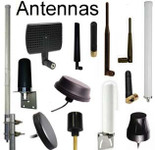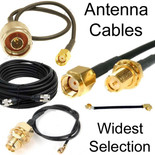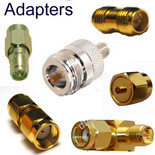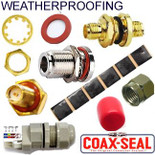Dual Polarity Antennas & MIMO (carrier-grade antennas)
Characteristics of Dual Polarity Antennas
- Have horizontal and vertical antennas in a same antenna.
- Antennas of dual polarity are high-speed, bandwidth for VOIP and streaming media
- Optimized for high density, high number of end-users of IP, VOIP, IPTV and HDTV cameras.
- Reduce costs of rent of the tower, since only an antenna will be needed for both polarities
- 2 x 2 in the title of a antenna on our website, means that they are antennas that are MIMO and dual-polarity

|

|
|

|

|
MIMO Carrier Grade Antennas:
802.11n 2x2 (MIMO) is based on spatial streams (different signal paths), so it works better with antennas with different polarization. Note that 2x2 = MIMO - but not necessarily dual-polarization: Because MIMO does work with antennas of the same polarity. For example a dual feeder for RocketM, H polarized only, works very good. A simple router has only 2-3 antennas of the same polarization. But with same polarity, there is a big chance of receiving signals with the same path, and you will not benefit of spatial stream.
MIMO makes antennas work smarter by enabling them to combine data streams arriving from different paths and at different times to effectively increase receiver signal-capturing power. Smart antennas use spatial diversity technology, which puts surplus antennas to good use. If there are more antennas than spatial streams, as in a 2x3 (two transmitting, three receiving) antenna configuration, then the third antenna can add receiver diversity and increase range.
- Reduces Tower rental costs as only 1 antenna needed for both polarities
Our WISP customers that are providing both data and VOIP services, insist on solutions that include dual-polarity antennas.
If you see 2x2 in a product title on our site, it is both MIMO and dual-polarity antennas
22-MILE LINK with true TCP @ 100Mbps One of our customers set up a 22 mile link with Mikrotik RB411AHs with R52HN radios connected to dual polarity Ubiquiti 30dBi dish antennas. The link has true TCP throughput over 100Mbps. The link it replaced with similar single polarity dish antennas had about 10 Mbps.
Just because an antenna is Dual polarity, does not mean that both polarities can be used at the same time by separate signals. The internal coax or copper wiring may be shared by the two polarities, and bonded together in some way. The Dual Polarity antenna has to be designed with two completely unique circuits to the antenna from the N connector, for both polarities to be used at the same time.
Secondly, Any two antenna elements near each other can work together two create the antenna beam: In the same way as an Omni or Panel antenna that is actually just several antenna elements placed so that they work together to increase gain and reduce beamwidth.
Its very common to use both polarities at the same time for the same signal, but a much different matter to have two separate signals and not have them interfere. Polarity isolation is often not enough when right next to each other. In theory, polarities of 90% difference equals 100% isolation, but in the real world its closer to 15-20 DB, but we're not sure if that is considering between the antennas elements right there, or signal coming from the environment getting shielded out.
Its very possible that 5.2 and 5.8 may not be far enough apart from each other to co-locate on the same antenna, however we do not know that for a fact (harmonics and such can play a part in this determination). However, we are aware of many successful implementations using 2.4 and 5.8 from the same antenna.
Not all Dual Polarity antennas are designed with the same signal characteristics and data stream characteristics: Data stream and signal characteristics of one, may not be the same as another.
Form an Array w/ 3 or 4 Sectoral Antennas on a Mast - Using Ubiquiti Rocket(s)
Use a cluster mount which enables you to cluster 3 or 4 Ubiquiti sectoral antennas in an array: There is an array mount for three (3-Gang Mount) and a 4-gang mount. We recommend that when you use a cluster mount for sectors, that you use the RF Armor shields to prevent the antennas' leakage from the back, from interfering with each other - and reduce the noise in general.
To connect multiple antennas to the same Rocket: You can if you use a " power divider" or antenna-combiner (not a coax-splitter): Please see this page on this subject.
The other solution would be to connect one rocket per antenna: Feedback from customers indicates that this is configuration is noisy - maybe too noisy, even with the RF Armor shields (which are sold separately from the array mounts). Of course, the purpose of the shields is to isolate each antenna and reduce the noise among the antennas.

Sectoral antenna array on 3-Gang Mount |

RF Armor Radome Shield Kit for Ubiquiti 120-degree Sector Antennas |

RF Armor Radome Shield Kit for Ubiquiti 90-degree Sector Antennas |
A dual-polarity antenna is an antenna that is capable of receiving and transmitting radiofrequency signals with two distinct forms of polarization (usually horizontal or vertical polarization), simultaneously.
Linearly polarized antennas radiate RF signals in one plane in the direction of propagation. Linearly polarized antennas can either be oriented vertically or horizontally, they also require alignment between transmitter and receiver. Circularly polarized antennas radiate RF in a cylindrical pattern.
Dual polarized antennas radiate in both the horizontal and vertical RF patterns, simultaneously.
The most significant advantage of dual polarity antenna over horizontal and vertical polarity antennas is their use in high-density environments. High population density areas have severe RF congestion: High levels of noise and interference. Dual polarity antennas overcome congestion by radiating in both horizontal and vertical patterns, whereas standard linearly-polarized antennas are radiating in only one linear pattern.
RF antennas can be polarized in one of three ways; Vertical polarization which is the most popular, horizontal polarization or the least commonly used circular polarization. The plane of the electric field determines the orientation of the RF waveform.
Antenna polarization refers to the orientation of the electromagnetic energy emitted or received by an antenna. A transmitted radio frequency signal consists of electrical and magnetic fields that travel at right angles to one another. Polarization is determined by the orientation and movement of the electrical field in relation to the earth. Antenna polarity may be:
- Linear: where the electrical field proceeds with oscillation in the horizontal plane, known as horizontal polarization, or the vertical plane known as vertical polarization. Slant polarization is another form of linear polarization where the electrical field is oriented at a 45-degree angle to the ground.
- Circular: where the electrical and magnetic fields rotate as the radio frequency signal propagates. This may be Right Hand Circular Polarization (RHCP) or Left Hand Circular Polarization (LHCP).
- Elliptical: where the movement of the propagated signal has an elliptical form.
Dual polarized or dual polarity antennas are functionally distinct from standard single polarized antennas though they may appear physically similar. Antennas that use vertical polarization and horizontal (V/H) polarization simultaneously can provide the functionality of two separate antennas in a single unit. This is achieved by multiple antenna elements, orthogonally arranged, being housed within the antenna radome. The dual linear polarized radiating elements may be dipoles, planar elements, or slots arranged at right angles or slanted at +45 degrees or -45 degrees to one another and arranged in front of a reflector to enhance directivity.
These antennas may be directional or omnidirectional depending on network requirements. Dual polarized antennas are able to improve the capacity and coverage that can be achieved with a wireless network as well as reduce overall costs.
Types of 5 GHz dual polarization antennas
There are several types of dual polarity antenna. In all cases, the singly polarized elements are housed within the antenna radome. These antennas are typically used as part of a base station arrangement:
[A] Dual polarity sector antennas transmit and receive with a sector-shaped radiation pattern in the horizontal plane. Coverage is typically 60, 90, or 120 degrees wide and multiple sector antennas can be combined to provide wider or omnidirectional coverage.
[B] Dual polarity parabolic or Dish antennas deliver a high degree of directivity and the focusing of the antenna beam means higher antenna gain can be achieved than with an equivalently powered omnidirectional antenna. The reflector directs the radio waves and in some designs houses the antenna elements.
[C] Directional dual polarity antennas are primarily used for point to point connections or wireless bridges and links over distance.
[D] Omnidirectional dual-polarized antennas provide 360-degree coverage making them advantageous for point to multipoint links and broadcasting to disparate outstations. They have a cylindrical radome which houses the horizontally and vertically polarized elements arranged in a bi-quadrature diversity format.
5 GHz dual polarity antennas operate at frequencies spanning 4.90 to 5.90 GHz, meaning that they can support communications that utilize the 5.0 and 5.9 GHz ISM frequency bands.
At these unlicensed frequencies, there is significant bandwidth available which facilitates high-speed data transfer, and less widespread use means less interference than at lower frequencies. The 5 GHz frequency band is divided into four sub-bands which are further divided into 20 MHz sub-channels:
- Band A Lower also known as UNII-1 spans 5180 MHz to 5240 MHz
- Band A Middle also known as UNII-2 spans 5260 MHz - 5320 MHz
- Band B Extended also known as UNII-2e spans 5500 MHz - 5720 MHz and can be used both outdoors and indoors.
- Band C Upper also known as UNII-3 spans 5745 MHz - 5805 MHz and is designated for outdoor use. It also has higher power limits in place than Band A and Band B.
Because of the availability of channels and the ability to merge channels into 40 MHz, 80 MHz, and 160 MHz wideband channels, it is often used for point-to-point connections or wireless bridges.
Although the 5 GHz frequency supports high-speed connectivity, its ability to penetrate solid objects is low and it displays optic phenomena, being easily reflected and refracted. This means that 5 GHz antennas used for 5 GHz wireless links need to be well aligned with a clear line of sight for optimal performance.
Why are 5 GHz dual polarity antennas important?
The massive expansion of wireless networking has meant that more and more bandwidth is needed for the high-density networking required to support vast numbers of networked devices.
With all this traffic, signal collisions are common, and at higher frequencies like 5 GHz, microwave signals are vulnerable to multipath interference, fading, and null effects, with resultant degradation of the network's performance.
Single polarity antennas contain vertically polarized elements and are likely to encounter signal collisions with transmissions from other vertically polarized antennas. The predominance of vertical polarization in single polarity antennas is because a horizontally polarized signal has greater vulnerability to the effects of obstacles and optical phenomena. A dual-polarity microwave antenna is capable of simultaneously transmitting and receiving two orthogonally oriented signals that cannot collide with each other as the half of the antenna elements transmit a vertically polarized signal and the other half a horizontally polarized signal. This vastly increases the traffic handling that is possible. Another advantage of dual polarity antennas is that they do not require any additional bandwidth for their operation which means that these antennas make efficient use of the available spectrum.
The use of fewer antennas also makes it easier to create a base station without reliance on spatial diversity as fewer dual-polarized antennas are needed. This of course reduces cost and also potential planning permission and access rights hurdles that often come with installing antennas.
5 GHz dual polarity antennas for polarization diversity
Dual polarized antennas are a necessary piece of equipment for implementing polarization diversity. This is a type of diversity scheme which involves multiple transmissions of a signal between two or more antennas with varying polarization of the transmitted signal. Other forms of antenna diversity include spatial diversity, frequency diversity, and time diversity. Diversity schemes are used to improve the robustness of a signal by using multiple communication channels with distinct characteristics. By varying the polarization of the transmitted signal problems like path loss, shadowing, fading and co-channel interference are reduced and multipath propagation which usually causes interference may even be exploited to strengthen a signal. The diversity gain from dual-polarization has been found in some studies to be slightly less than the gain that can be achieved by spatial diversity, but in scattering environments, the performance is broadly equivalent. The use of dual polarity transmitting and receiving antennas means that at least two transmission paths are created which carry the same signal but have been affected by the surrounding environment differently. This means their fading characteristics will differ, but if the signal strength is comparable, the received signals can be combined into an improved signal, and the data recovered. The improvement in signal is described as diversity gain, which is a comparison of signal strength between the transmitted signal and the signal after diversity combining has taken place. Diversity combining is most often accomplished by using one of the following techniques:
- Signal selection, where the path with the highest signal-to-noise ratio is selected.
- Maximum ratio, which involves all paths being optimally combined by amplitude and phase.
The orthogonal arrangement of the polarizations is key to delivering two completely distinct signals, with a 45-degree slant arrangement delivering greater signal strength than a horizontal/vertical system. Effective separation of the two polarizations is key to optimal performance but almost all dual polarity antennas have some degree of cross-coupling. The degree of separation of the two polarizations is measured by antenna isolation (a ratio of transmitted and received power) and cross-polarization discrimination.
5 GHz cross-polarized antennas for MIMO networking
Dual polarity antennas can be used to multiply wireless link capacity in a Multiple Input Multiple Output (MIMO) arrangement. MIMO is a feature of some widely used wireless and cellular networking standards including:
- WiFi: The 802.11n protocol contains specifications for networking with up to four simultaneous data streams. The number of data streams is normally limited by the number of antennas that are set up on both sides of the link, however, dual-polarity antennas reduce the number of antennas while maintaining the number of data streams that can be supported provided there is sufficient radio capacity to handle the data streams. IEEE 802.11ac increases the number of spatial streams that can be supported simultaneously to eight.
- WiMAX: based on the 802.16 wireless networking standards uses the 5 GHz frequency for local area networking. 2x2 MIMO dual polarity client and sector antennas can be used to improve spectral efficiency and performance of high-speed wireless links.
2x2 MIMO connectivity can be readily achieved by dual polarity antennas. The polarization diversity in these MIMO setups means that two independent data streams are established. Polarization diversity also means that multiple transmitting and receiving antennas are not required to multiply a wireless link. The focus is the simultaneous transmission and receipt of more than one data signal over the same channel, harnessing multipath propagation, to achieve improved data transfer and frequency reuse. There are two key forms of polarization diversity used in MIMO networking:
- Polarization Division Multiple Access (PDMA) involves a dual polarized transmitting antenna being used to transmit two data streams to different users simultaneously.
- Space Polarization Division Multiple Access (SPDMA) combines both spatial diversity and polarization diversity within a dual-polarized MIMO set up for even greater gains in spectral efficiency.
Any polarization mismatch will degrade the MIMO system performance so the antennas must be carefully aligned and paired. Scalable MIMO installations can be used to create massive MIMO systems which have the connectivity and data processing capacity to support expansive or infrastructural Internet of Things (networks).
Frequently asked questions
What is multipath?
Multipath refers to the multiple (two or more) paths a transmitted signal may take to reach the receiver. This form of signal propagation is caused by environmental effects on the signal as it travels, including reflection and refraction off objects, surfaces, and bodies of water. Where this phenomenon is pronounced it can cause radio frequency interference. This is because multiple versions of the transmitted signal reach the receiver, separated by time and differing in strength. The overall received signal is either increased in strength or diminished causing fading and even canceling out of the original signal. Polarization diversity and MIMO mitigate the effects of multipath by and MIMO by either combining or selecting from multiple data streams that arrive via different paths and at varying times.
What is backhaul?
The backhaul is a critical part of a wireless or telecommunications network. It comprises the immediate connections between the backbone of the network and the smaller subordinate networks that it supplies. Connectivity to the core network is supplied by the backhaul via wireless point to point or point to multipoint connections. Depending on the type of network protocol used, backhaul connections are usually high capacity and high throughput with gigahertz per second speeds possible. They are capable of supporting the long-range networking necessary for connectivity in public hotspots and large outdoor spaces.
Wireless backhaul is less expensive to install than fiber or wireline networking which may also have the planning implications of laying cable. It also can be deployed faster and is suited to complex urban environments. Wireless backhaul can be used to create WiFi mesh networks that are capable of drastically increasing WiFi coverage in a geographical area. Within these networks, dual-polarity antennas provide high-speed signal relay from multiple access points and forward data packets within multi-hop network arrangements.
What is a base station?
Base stations serve as hubs for wireless networking and are comprised of an array of transmitting and receiving antennas. Dual polarity antennas can be installed as part of a base station set up, reducing the number of antennas required if properly configured. It can also serve as an access point or gateway between cabled and wireless networks.
What is point-to-point?
A point-to-point connection is a connection made between two fixed points. With wireless networking, point-to-point connectivity is established between two antennas or multiple antennas in a MIMO arrangement. Wireless point-to-point connections may be:
- Wireless links: these are data links between two nodes or endpoints through which data packets are exchanged, usually on a bidirectional basis. Microwave frequency wireless links can cover large distances if they have an unobstructed line of sight present. Antenna selection is critical to the performance of such links and dual-polarity parabolic dish antennas are particularly suited (due to their high directivity) to providing high speed and bandwidth wireless links.
- Wireless bridges: are point-to-point links that connect two distinct and physically separate networks wirelessly. It is used to provide high-throughput connectivity in circumstances where a cabled connection would be impractical.
What is a point-to-multipoint connection?
Point-to-multipoint connections are wireless connections where radio communication is established between a fixed central node and multiple disparately distributed fixed endpoints or nodes. Gigahertz-range point-to-multipoint connections are capable of supporting large numbers of end-users and usually require the erection of a base station with omnidirectional or sector antennas to distribute the wireless signal with broad coverage.
What is a node?
In wireless networks, nodes function as either a point of signal redistribution or an endpoint. Networked objects or devices that are connected to a particular network function as nodes. Depending on their level of functionality nodes are capable of sending, receiving, and forwarding on data.
Which cables and adapters?
Dual-polarity antennas come with various connector types. Ensure you have the compatible cable for your antenna. Common antenna cable types include U.FL (for miniature antennas) and SMA cables. In some cases, you might need adapter cables like SMA to U.FL or RP-SMA to U.FL depending on your antenna and existing equipment.
In conclusion
Dual polarity microwave antennas support robust, reliable, and high-speed wireless connectivity. They can be used to improve Signal to Noise Ratio (SNR) or as part of a MIMO or polarization diversity scheme. The range of cross polarity 5 GHz antennas available means that setting up wireless broadband or WiFi over a wide area is a straightforward task.
LEARN MORE:
Posted by George Hardesty on 23rd Jul 2022



























